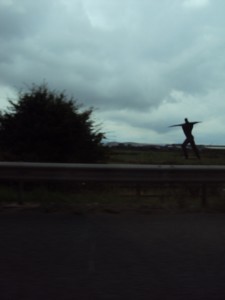Mistaking a Monster
Posted by: Nick Redfern on May 12th, 2012

In my latest Lair of the Beasts post over at Mania.com, I begin thus:
“When it comes to reports of Bigfoot, I’m pretty sure that the vast majority of people I’ve interviewed who have claimed sightings of such creatures are utterly genuine, honest, looking for answers, and have indeed seen something very weird. And, occasionally and unfortunately, you get a hoaxer here and there. But there’s another category, too: mistaken identity.
“It barely needs mentioning that there aren’t many things in Britain that one could conceivably mistake for Bigfoot, and so – for that very important reason alone – the number of cases I have on file is very limited. Actually, ‘cases’ is the wrong word to use, since I only possess one, solitary account that can be said to fall into this particular category marked ‘Mistake.'”
And, as I note in the article, the case is a very, very weird and cautionary one, too…
About Nick Redfern
Punk music fan, Tennents Super and Carlsberg Special Brew beer fan, horror film fan, chocolate fan, like to wear black clothes, like to stay up late. Work as a writer.










While one might see this case as a “cautionary one,” consider it from the opposite side: she didn’t make it up; in fact, the woman provided what turned-out to be an accurate description of what she observed!
So, for those who dismiss sighting reports out-of-hand, don’t be too sure that witnesses didn’t see exactly what they reported. Now, whether what was seen was really a stump, a giant stick figure, or Bigfoot himself; that’s where the real work – follow-up investigation – begins…
Misidentifications are a huge part of the debunking tool kit. Often debunkers who suggest a misidentification are shouted down, but it seems like a reasonable place to start.
Misidentification might be an issue in cases like these:
1) somebody hears that a red panda is on the loose (real case). the person catches a brief glimpse of a cat, or a fox, or a badger, and isn’t totally sure as the sighting was brief. But the person wants to help, and reports it, maybe including their uncertainty what it was.
2) somebody sees a guy clad all in black top to toe, including hoodie, at a distance, a BIG guy, and a considerable distance. He wants to help, so he reports it as a possible bigfoot, maybe including his uncertainty. (Right. I don’t see many dressed like that either.)
3) somebody in one of the above cases is dead certain (and wrong). But I just don’t think that happens much to a person who doesn’t have An Agenda. As most cryptid sighters don’t – they don’t really want to have seen what they saw – I don’t think this one happens often.
As to Bigfoot in Britain, another situation in which misidentifications might loom large is a really small sample size. For sasquatch in North America, in no way do misidentifications seem significant. There’s too much evidence and it’s too consistent to make that likely. (I have read virtually no accounts that do not come down to: sasquatch; hospitalizable mental malfunction; or downright lie.) But for something that the volume of evidence doesn’t seem to indicate attaches to an unknown phenomenon, that might be another story.
Having read the linked story and seen the figure
1) Most bigfoot sightings I’ve read are nothing like this case. They involve a subject that was clearly moving on its own, and considerably more detail;
2) Most bigfoot reports don’t involve somebody getting a passing glimpse of something, then immediately reporting it over the phone as a bigfoot;
3) Almost no bigfoot reports involve something with a cultural precedent like this one (unless one wants to include somebody thinking a bigfoot statue is a bigfoot).
Massachusetts:
Misidentifications shouldn’t be such a “huge” part of the true skeptic’s debunking tool kit.
To rule misidentification requires one of two things:
1) One or more individuals present at the scene at the time who report something different, and whose reports make it clear that theirs is a reasonable interpretation compared to that of the dissenting witness;
2) A description provided by the witness that allows subsequent debunking by an investigator at the scene (as in this instance).
One should also have
3) A scenario in which the reported sighting simply does not seem likely. (The bigfoot-in-Britain sighting file simply is not large, as noted here.)
Too often skeptics shout “misidentifcation” as an off-the-cuff kneejerk debunk, a decidedly improper use. It frequently bespeaks bald-faced disregard of the evidence. The best example is its use to downplay sasquatch and yeti sightings. As I note, for most sasquatch sightings I have read, that the animal sighted was a sasquatch is actually the most mundane explanation; there’s simply no way the creature described could be a known animal unless the sighter was either mentally impaired or lying, and there is a very large body of evidence.
When I hear “misidentification” I simply reply: excuse me. Were you there?
If you weren’t, you are likely speaking out of turn.